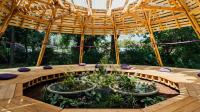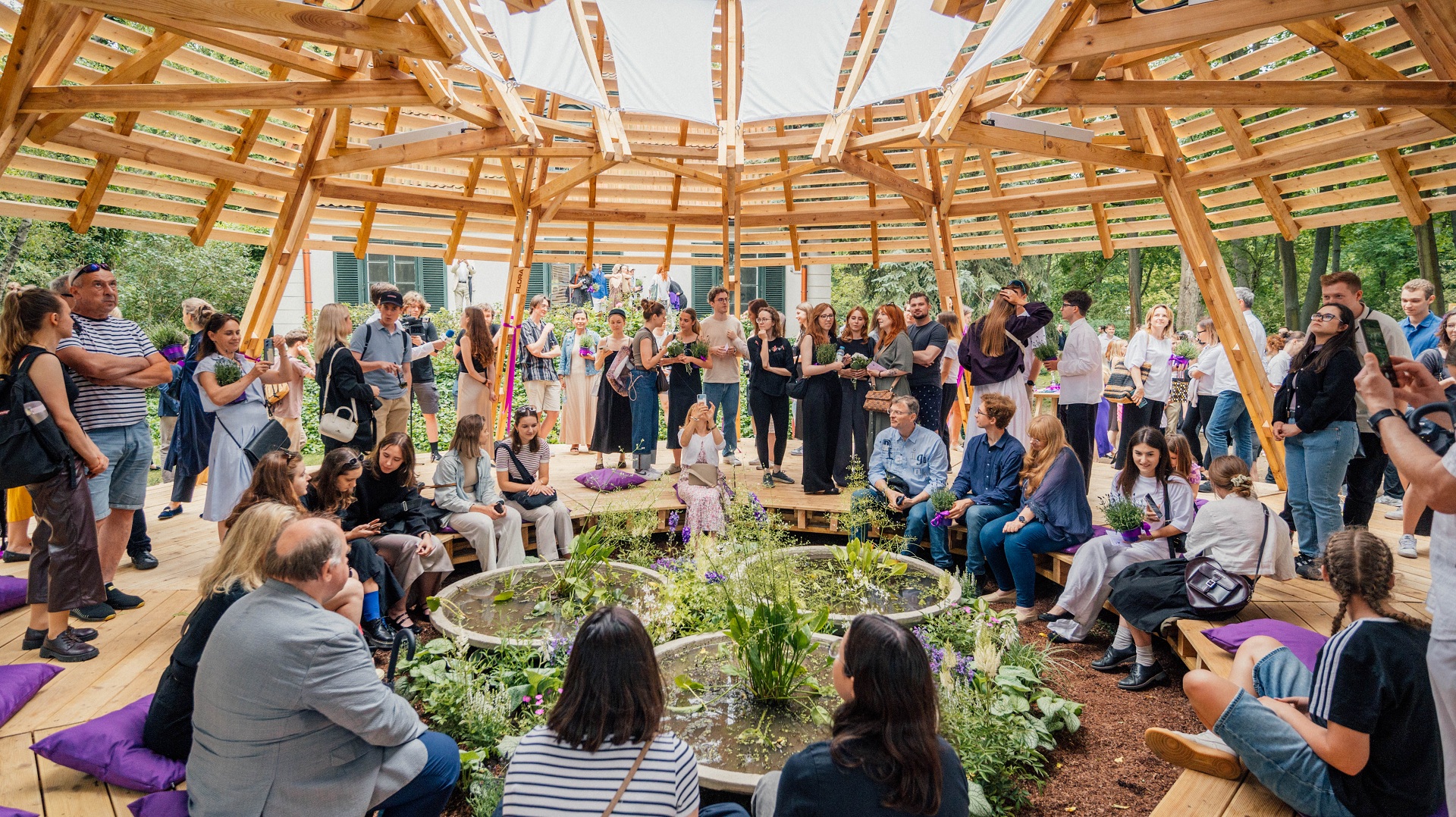Community Pavilion – student project erected in the Łazienki Królewskie Park
Next to the Hermitage building in the premises of the Łazienki Królewskie Museum, the Community Pavilion was erected – created by teachers and students of the WUT Faculty of Architecture under the initiative ”Stawiamy_” (We Erect).
”Stawiamy_” is a unique teaching and social initiative run by the Division of Architectural and Urban Design at the Warsaw University of Technology Faculty of Architecture. Its initiator and coordinator is Anna Maria Wierzbicka, PhD. The programme is a response to changing needs of architectural education – by combining design, implementation and social dimension.
In 2025, there was the third edition of the initiative, ”Community”, which concentrated on the topic of architecture as the space of relationships. The previous editions were ”Freedom” (2023) and ”Future” (2024). Each edition concludes with the erection of a pavilion – from the concept through implementation project, up to its physical construction and use in public space.
Like in previous editions, the initiative partner is the Łazienki Królewskie Museum, headed by Marianna Otmianowska with her team. The pavilion was erected in a special place behind the Hermitage, beautifully blending into the context of the historical garden.
The opening celebration of the pavilion is each year accompanied by a lecture by a special guest. In previous years these were, for example, Shigeru Ban and Roger Boltshauser (ETH Zurich). The year our invitation was accepted by as many as three special guests: Professor Tom Avermaete (ETH Zurich), Miguel Pallares Lopez (partner at Piuarch Studio in Milan) and Kazuhiro Yajima (architect and visiting scientist at TU Vienna).
Education through work
The ”Stawiamy_” initiative is run within the specialisation A3: Architecture, Technology and Structure. It stands out through its use of narrative methodology – architecture can and should tell a story. Students work in two-member teams, which then turns into a competition – they present concepts, use 1:50 models, prepare graphic presentations, projections and sections. In this year’s edition, there were 15 concepts of pavilions, from which, through voting by students, teachers and external experts, one project was chosen for implementation, which was then developed jointly and adapted to construction conditions (technical, legal, financial). The chosen project had the motto “symbiosis”.
After the project was selected, students were divided into three functional teams:
- marketing team – responsible for the project’s communication strategy; they created information and promotion materials. They cooperated with the company Urban Jungle, which offers professional PR.
- project team – responsible for completion of the building and implementation project, preparation of applications to the Art Restorer and obtaining a building permission.
- implementation and building team – completed physical construction of the pavilion, planned the logistics, organised the construction schedule; they were responsible for materials orders and completion of work on site.
Each team had a leader (head) who coordinated the work, delegated tasks and reported on the team’s progress. In this way, students learnt responsibility, planning and architectural project management to the full extent.
Architecture as a space of relationships
– The ”Community” Pavilion was created as a space for dialogue between human, nature and architecture – says Anna Maria Wierzbicka, PhD, project leader. – Its form refers to the idea of symbiosis – this year’s leading concept – understood as co-existence and mutual support of various elements of the world. Community is presented here not only as a human relationship, but also as spiritual, physical and symbolic connection of the human with the surrounding nature.
The pavilion’s architecture is based on a circular plan, symbolizing equality, the cyclical nature of life, and the infinity of relationships. Twelve columns supporting the roof refer to the twelve months, the natural order, and the life cycle. The structure, made of natural wood, reflects the delicacy and interdependence of all elements - none can exist without the others.
At the centre of the pavilion are three planters with aquatic and marsh plants, inspired by a pre-war design by Alina Scholtz, a pioneer of Polish landscape architecture. Water, light, and vegetation serve as symbolic pillars of the space - evoking the forces of nature, the source of life, and the cycle of renewal.
– The ”Community” Pavilion serves not only people but also teaches humility towards the natural world – as a significant cocreator of architecture – points out Anna Maria Wierzbicka, PhD. – Each visitor can feel part of a greater whole – community that transcends the borders of time, function and matter.
Second life of the pavilions
The pavilions created under the ”Stawiamy_” initiative get a second life – they do not finish their role with the end of the summer season but they get new locations and functions, taking with them the values they were designed for.
The Freedom Pavilion, completed in 2023, was moved to the Vistula River Bank, where it became a social space at Płyta Desantu. It was also recognised outside of Poland – it received a prestigious award in the United States.
The Future Pavilion from 2024 created in cooperation with XY Studio (and Unibep and Unihouse) was transported to Dom Matki Bożej Serdecznej, run by Małgorzata Chmielewska at 10, Foliałowa Street in Warsaw. There it serves people in the homelessness crisis supporting the concept of socially engaged architecture.
There is also a plan for the future of the Community Pavilion – we will inform you about that.
Now we invite you to visit the Community Pavilion at Łazienki Królewskie behind the Hermitage (1A, Myśliwiecka Street) during the holidays.
Team leading the project:
- Anna Maria Wierzbicka, PhD – specialisation head
- Maciej Kaufman, MSc
- Szymon Kalata, MSc
- Kinga Zinowiec-Cieplik, PhD – landscape architecture
- Mariusz Wrona, MSc – constructions
Urban planning consultations:
- Paweł Trębacz, PhD
- Renata Jóźwik, PhD
- Magdalena Duda, MSc
Students of the A3 specialisation:
Bielan Anastasiia, Całka Zofia, Danilczuk Łukasz, Fedorchuk Kseniia, Gancarczyk Zofia, Janowski Aleksander, Kassowski Szymon, Kochanowska Klaudia, Koperska Julia, Kordalska Maja, Krawiecka Barbara, Kucharczyk Szymon, Lechowska Hanna, Maniak Ewa, Marczak Piotr, Oberzig Maciej, Olko Maria, Robak Mateusz, Rorat Karolina, Szewczak Gabriela, Szewczyk Natalia, Sikora Katarzyna, Smolińska Magdalena, Sułecka Aleksandra, Świstuniuk Julia, Wiązowski Jakub, Wolska Maria, Zagajewski Dominik, Zioło Alicja, Zwierzchowski Jan, Zwijacz Zofia
Sponsors and support:
The ”Stawiamy_” initiative would not be possible without the engagement of many partners and sponsors. The biggest are:
- Flora Development – main sponsor for three years
- Warsaw University of Technology
- Łazienki Królewskie Museum
-
Hilti, Ramirent, Schréder, Łuksiewicz, Oltens, Unibep Group.
and companies cooperating with the initiative: Grochowski Konstrukcje, Urban Jungle, Kompex Marcet, Grupa Centrala.
Full list of partners and more about the ”Stawiamy_” initiative can be found on: stawiamyna.pl.










